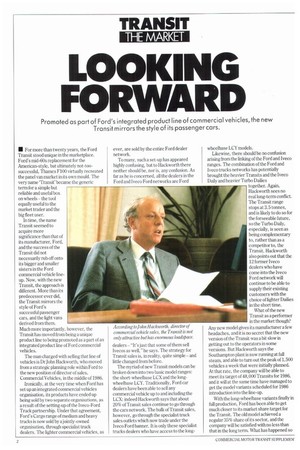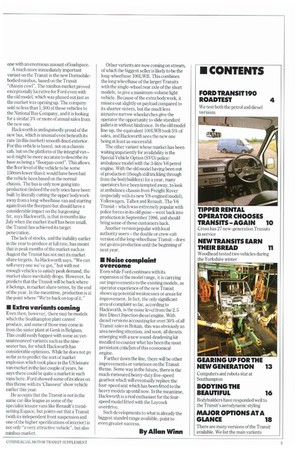LOOKING FORWARD
Page 102

Page 103

If you've noticed an error in this article please click here to report it so we can fix it.
Promoted as part of Ford's integrated product line of commercial vehicles, the new Transit mirrors the style of its passenger cars.
• For more than twenty years, the Ford Transit stood unique in the marketplace. Ford's mid-60s replacement for the American-style, but ultimately not-toosuccessful, Thames F100 virtually recreated the panel van market in its own mould. The very name Transit' became the generic term for a simple but reliable and useful box on wheels—the tool equally useful to the market trader and the big fleet user.
In time, the name Transit seemed to acquire more significance than that of its manufacturer, Ford, and the success of the Transit did not necessarily rub off onto its bigger and smaller sisters in the Ford commercial vehicle lineup, Now, with the new Transit, the approach is different. More than its predecessor ever did, the Transit mirrors the style of Ford's successful passenger cars, and the light vans derived from them. Much more importantly, however, the Transit has moved from being a unique product line to being promoted as a part of an integrated product line of Ford commercial vehicles.
The man charged with selling that line of vehicles is DrJohn Hackworth, who moved from a strategic planning role within Ford to the new position of director of sales, Commercial Vehicles, in the middle of 1986.
Ironically, at the very time when Ford has set up an integrated commercial vehicles organisation, its products have ended up being sold by two separate organisations, as a result of the setting-up of the Iveco-Ford Truck partnership. Under that agreement, Ford's Cargo range of medium and heavy trucks is now sold by a jointly-owned organisation, through specialist truck dealers. The lighter commercial vehicles, as ever, are sold by the entire Ford dealer network.
To many, such a set-up has appeared highly confusing, but to Hackworth there neither should be, nor is, any confusion. As far as he is concerned, all the dealers in the Ford and Iveco Ford network-: arc Ford dealers — "It's just that some of them sell Ivecos as well," he says. The strategy for Transit sales is, in reality, quite simple — and little changed from before.
The myriad of new Transit models can be broken down into two basic model ranges: the short-wheelbase LCX and the longwheelbase LCY. Traditionally, Ford car dealers have been able to sell any commercial vehicle up to and including the LCX: indeed Hackworth says that about 20% of Transit sales continue to go through the cars network. The bulk of Transit sales, however, go through the specialist truck sales outlets which now trade under the Iveco Ford banner. It is only these specialist trucks dealers who have access to the long wheelbase LCY models.
Likewise, there should be no confusion arising from the finking of the Ford and Iveco ranges. The combination of the Ford and Iveco trucks networks has potentially brought the heavier Transits and the Iveco Daily and heavier Turbo Dailies together. Again, Hackworth sees no real long-term conflict The Transit range stops at 3.5 tonnes, and is likely to do so for the forseeable future, SO the Turbo Daily, especially, is seen as being complementary to, rather than as a competitor to, the Transit. Hackworth also points out that the 12 former Iveco dealers who have come into the Iveco Ford network will continue to be able to supply their existing customers with the choice of lighter Dailies in the short time.
What of the new Transit as a performer in the market though? Any new model gives its manufacturer a few headaches, and it is no secret that the new version of the Transit was a bit slow in getting out to the operators in some versions. But Hackworth says the Southampton plant is now running at full steam, and able to turn out the peak of 1,500 vehicles a week that were initially planned. At that rate, the company will be able to meet its target of 48,000 Transits for 1986, and it will at the same time have managed to get the model variants scheduled for 1986 introduction into the line-up.
With the long-wheelbase variants finally in full production, Ford has been able to get much closer to its market share target for the Transit. The old model achieved a regular 35% share of its sector, and the company will be satisfied with no less than that in the long term. What has happened so one with an enormous amount of loadspace.
A much more immediately important variant on the Transit is the new Dormobilebodied minibus, based on the Transit "chassis cowl", The minibus market proved exceptionally lucrative for Ford even with the old model, which was phased out just as the market was opening up. The company sold no less than 1,500 of these vehicles to the National Bus Company, and it is looking for a similar 3% or more of annual sales from the new one, Hackworth is undisguisedly proud of the new bus, which is unusual even beneath its rare (in this market) smooth-lined exterior. For this vehicle is based, not on a chassis cab, but on the platform of the integral van — so it might be more accurate to describe its base as being a "floorpan-cowl". This allows the floor level of the vehicle to be some 150mm lower than it would have been had the vehicle been based on the normal chassis. The bus is only now going into production (indeed the early ones have been built by literally cutting the upper bodywork away from a long-wheelbase van and starting again from the floorpan) but should have a considerable impact on the burgeoning far, says Hackworth, is that in months Like July when the market itself has been small, the Transit has achieved its target penetration.
The lack of stocks, and the inability earlier in the year to produce at full rate, has meant that in peak months of the market such as August the Transit has not met its market share targets. As Hackworth says, "We can sell every one we've got," but with not enough vehicles to satisfy peak demand, the market share inevitably drops. However, he predicts that the Transit will be back where it belongs, in market share terms, by the end of the year. In the meantime, production is at the point where "We're back on top of it."
• Extra variants coming
Even then, however, there may be models which the Southampton plant cannot produce, and some of those may come in from the sister plant at Genk in Belgium. This could easily happen with some as-yetunannounced variants such as the nineseater bus, for which Hackworth has considerable optimism. While he does not go so far as to predict the sort of market explosion which took place in the US leisure van market in the last couple of years, he says there could be quite a market in such vans here. Ford showed some of its ideas on this theme with its 'Chasseur' show vehicle earlier this year.
He accepts that the Transit is not in the same car-like league as some of the specialist leisure vans like Renault's trendsetting Espace, but points out that a Transit (with its independent front suspension and one of the higher specifications of interior) is not only "a very attractive vehicle", but also minibus market. Other variants are now coming on stream, of which the biggest seller is likely to be the long-wheelbase 100LWB. This combines the long wheelbase of the larger Transits with the single-wheel rear axle of the short models, to give a maximum-volume light vehicle. Because of the extra bodywork, it misses out slightly on payload compared to its shorter sisters, but the much less intrusive narrow wheelarches give the operator the opportunity to slide standard pallets in without hindrance. In the old model line-up, the equivalent 100LWB took 5% of sales, and Hackworth sees the new one being at least as successful.
The other variant whose market has been waiting impatiently for availability is the Special Vehicle Option (SVO) police/ ambulance model with the 3-litre V6 petrol engine. With the old model having been out of production (though still trickling through from the bodybuilders) for a year, many operators have been tempted away, to look at ambulance chassis from Freight Rover (especially with its new V8-engined model), Volkswagen, Talbot and Renault. The V6 Transit — which was extremely popular with police forces in its old guise — went back into production in September 1986, and should bring some of those customers back.
Another version popular with local authority users — the double or crew-cab version of the long-wheelbase Transit — does not go into production until the beginning of next year.
• Noise complaint overcome
Even while Ford continues with its expansion of the model range, it is carrying out improvements to the existing models, as operator experience of the new Transit shows up potential weaknesses or areas for improvement. In fact, the only significant area of complaint so far, according to Hackworth, is the noise level from the 2.5 Litre Direct Injection diesel engine. With diesel versions accounting for over 30% of all Transit sales in Britain, this was obviously an area needing attention, and soon, all diesels emerging with a new sound-deadening kit installed to counter what has been the most persistant criticism of this economical engine.
Further down the line, there will be other improvements or variations on the Transit theme. Some way in the future, there is the much-rumoured heavy-duty five-speed gearbox which will eventually replace the four-speed unit which has been fitted to the heavy models up until now. In the meantime, Hackworth is a real enthusiast for the fourspeed model fitted with the Laycock overdrive.
Such developments to what is already the biggest standrd range available, point to even greater success.
By Allan Winn
























































































































